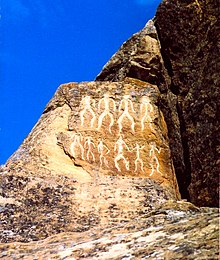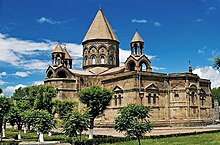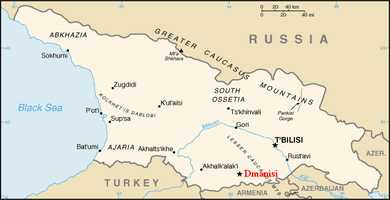| Revision as of 17:05, 12 December 2015 editLouisAragon (talk | contribs)Autopatrolled, Extended confirmed users, Pending changes reviewers, Rollbackers71,884 edits what are you seriously talking about?← Previous edit | Revision as of 17:10, 12 December 2015 edit undoDamianmx (talk | contribs)Extended confirmed users1,862 edits Undid revision 694933858 by LouisAragon (talk)Next edit → | ||
| Line 6: | Line 6: | ||
| | caption = Caucasus mountain range | | caption = Caucasus mountain range | ||
| | label1 = Countries | | label1 = Countries | ||
| | data1 = {{ublist|class=nowrap |{{flagicon|Armenia}} ]|{{flagicon|Azerbaijan}} ]|{{flagicon|Georgia}} ] |
| data1 = {{ublist|class=nowrap |{{flagicon|Armenia}} ]|{{flagicon|Azerbaijan}} ]|{{flagicon|Georgia}} ] {{flagicon|Russia}} ]|{{flagicon|Turkey}} ]}} | ||
| | label2 = Partially or unrecognized states | | label2 = Partially or unrecognized states | ||
| | data2 = {{ublist|class=nowrap |] | | data2 = {{ublist|class=nowrap |] | ||
Revision as of 17:10, 12 December 2015
This article is about the geographic region in Eurasia. For other uses, see Caucasus (disambiguation) and Caucasia (disambiguation).| Caucasus | |
|---|---|
 Caucasus mountain range Caucasus mountain range | |
| Countries | |
| Partially or unrecognized states | |
| Time Zones | UTC+4:00, UTC+5:00, UTC+03:00 |

The Caucasus /ˈkɔːkəsəs/ or Caucasia /kɔːˈkeɪʒə/ is a region at the border of Europe and Asia, situated between the Black and the Caspian seas.
It is home to the Caucasus Mountains, which contain Europe's highest mountain, Mount Elbrus. Politically, the Caucasus region is separated between northern and southern parts. The southern parts consist of independent sovereign states, and the northern parts are under the jurisdiction of the Russian Federation.
The region is known for its linguistic diversity: aside from Indo-European and Turkic languages, the Kartvelian, Northwest Caucasian, and Northeast Caucasian families are indigenous to the area.
Name
Pliny the Elder's Natural History (AD 77–79) derives the name of the Caucasus from the Scythian kroy-khasis (“ice-shining, white with snow”).


Modern endonyms
- Template:Lang-ab Kawkáz
- Template:Lang-ady Qawqaz
- Template:Lang-az
- Template:Lang-ar al-Qawqāz
- Template:Lang-hy Kovkas
- Template:Lang-av Kawkaz
- Template:Lang-ce Kawkáz
- Georgian: კავკასია K'avk'asia
- Template:Lang-gr Kávkasos
- Template:Lang-inh Kawkaz
- Template:Lang-kbd Qawqaz
- Template:Lang-krc Kawkaz
- Template:Lang-ku
- Template:Lang-lez K'awk'az
- Template:Lang-lbe Kkawkkaz
- Template:Lang-os Kavkaz
- Template:Lang-fa Qafqaz
- Template:Lang-ru Kavkaz
- Template:Lang-tr
- Template:Lang-uk Kavkaz
History
Further information: History of the Caucasus


Located on the peripheries of Turkey, Iran, and Russia, the region has been an arena for political, military, religious, and cultural rivalries and expansionism for centuries. Throughout its history, the Caucasus was usually incorporated into the Iranian world. At the beginning of the 19th century, the Russian Empire conquered the territory from Iran.
Under Ashurbanipal (669–627 BC) the boundaries of the Assyrian Empire reached as far as the Caucasus Mountains. Later ancient kingdoms of the region included Armenia, Albania, Colchis and Iberia, among others. These kingdoms were later incorporated into various Iranian empires, including Media, the Achaemenid Empire, Parthia, and the Sassanid Empire, who would altogether rule the Caucasus for many hundreds of years. In 95–55 BC under the reign of Armenian king of kings Tigranes the Great, the Kingdom of Armenia became an empire, growing to include: Kingdom of Armenia, vassals Iberia, Albania, Parthia, Atropatene, Mesopotamia, Cappadocia, Cilicia, Syria, Nabataean kingdom, and Judea. By the time of the first century BC, Zoroastrianism had become the dominant religion of the region; however, the region would go through two other religious transformations. Owing to the strong rivalry between Persia and Rome, and later Byzantium, the latter would invade the region several times, although it was never able to hold the region.
As the Arsacid dynasty of Armenia (an eponymous branch of the Arsacid dynasty of Parthia) was the first nation to adopt Christianity as state religion (in 301 AD), and Caucasian Albania and Georgia had become Christian entities, Christianity began to overtake Zoroastrianism. With the Muslim conquest of Persia, the region came under the rule of the Arabs. In the 10th century, the Alans (proto-Ossetians) founded the Kingdom of Alania, that flourished in the Northern Caucasus, roughly in the location of latter-day Circassia and modern North Ossetia–Alania, until its destruction by the Mongol invasion in 1238–39. In the 12th century, the Georgian king David the Builder drove the Muslims out from Caucasus and made the Kingdom of Georgia a strong regional power. In 1194–1204 Georgian Queen Tamar's armies crushed new Seljuk Turkish invasions from the south-east and south and launched several successful campaigns into Seljuk Turkish-controlled Southern Armenia. The Georgian Kingdom continued military campaigns in the Caucasus region. As a result of her military campaigns and the temporary fall of the Byzantine Empire in 1204, Georgia became the strongest Christian state in the whole Near East area, encompassing most of the Caucasus stretching from Northern Iran and Northeastern Turkey to the North Caucasus. The Caucasus region would later be conquered by the Ottomans, Mongols, local kingdoms and khanates, as well as, once again, Iran.
Up to including the early 19th century, the Southern Caucasus and a part of the Northern Caucasus (Dagestan) all formed part of the Persian Empire. In 1813 and 1828 by the Treaty of Gulistan and the Treaty of Turkmenchay respectively, the Persians were forced to irrevocably cede the Southern Caucasus and Dagestan to Imperial Russia. Russia conquered and annexed the rest of the Northern Caucasus in the course of the 19th century in the Caucasian Wars (1817–1864).
The region was unified as a single political entity twice – during the Russian Civil War (Transcaucasian Democratic Federative Republic) from 9 April 1918 to 26 May 1918, and under the Soviet rule (Transcaucasian SFSR) from 12 March 1922 to 5 December 1936.
In the 1940s, around 480,000 Chechens and Ingush, 120,000 Balkars, Karachays, and Meskhetian Turks, and 200,000 Kurds and Caucasus Germans were deported en masse to Central Asia and Siberia. About a quarter of them died.
Following the dissolution of the Soviet Union in 1991, Georgia, Azerbaijan and Armenia became independent nations. The Caucasus region has been subject to various territorial disputes since the collapse of the Soviet Union, leading to the Nagorno-Karabakh War (1988–1994), the Ossetian-Ingush conflict (1989–1991), the War in Abkhazia (1992–93), the First Chechen War (1994–1996), the Second Chechen War (1999–2009), and the 2008 South Ossetia War.
Prehistory

The territory of the Transcaucasus region was inhabited by Homo erectus since the Paleolithic Era. In 1991, early human (that is, hominin) fossils of 1.8 million years age were found at the Dmanisi archaeological site, in Georgia, in the southern Caucasus. Scientists now classify the assemblage of fossil skeletons as the subspecies Homo erectus georgicus.
The site yields the earliest unequivocal evidence for presence of early humans outside the African continent; and the Dmanisi skulls are the five oldest hominins ever found outside Africa, thereby doubling the presumed age of the human migration outside the continent.
Political geography





The northern portion of the Caucasus is known as the Ciscaucasus and the southern portion as the Transcaucasus.
The Ciscaucasus contains the larger majority of the Greater Caucasus Mountain range, also known as the Major Caucasus mountains. It includes Southwestern Russia and northern parts of Georgia and Azerbaijan.
The Transcaucasus is bordered on the north by Russia, on the west by the Black Sea and Turkey, on the east by the Caspian Sea, and on the south by Iran. It includes the Caucasus Mountains and surrounding lowlands. All of Armenia, Azerbaijan (excluding the northern parts) and Georgia (excluding the northern parts) are in South Caucasus.
The main Greater Caucasus range is generally perceived to be the dividing line between Asia and Europe. The highest peak in the Caucasus is Mount Elbrus (5,642 m) in the western Ciscaucasus in Russia, and is generally considered as the highest point in Europe.
The Caucasus is one of the most linguistically and culturally diverse regions on Earth. The nation states that comprise the Caucasus today are the post-Soviet states Georgia, Armenia, and Azerbaijan. The Russian divisions include Krasnodar Krai, Stavropol Krai, and the autonomous republics of Adygea, Karachay–Cherkessia, Kabardino-Balkaria, North Ossetia, Ingushetia, Chechnya, and Dagestan. Three territories in the region claim independence but are recognized as such by only a handful or by no independent states: Nagorno-Karabakh, Abkhazia and South Ossetia.
| North Caucasus | South Caucasus |
|---|---|
* States in italics are largely unrecognised. Abkhazia and South Ossetia are recognised as part of Georgia, and Nagorno-Karabakh is recognised as part of Azerbaijan.
Demographics

The region has many different languages and language families. There are more than 50 ethnic groups living in the region. No less than three language families are unique to the area, but also Indo-European languages, such as Armenian and Ossetic, and Turkic languages, such Azerbaijani and Karachay-Balkar, are spoken in the area. Russian is used as a common language.
Today the peoples of the Northern and Southern Caucasus tend to be either Eastern Orthodox Christians, Oriental Orthodox Christians, or Sunni Muslims. Shia Islam has had many adherents historically in Azerbaijan, located in the eastern part of the region.
Mythology
In Greek mythology the Caucasus, or Kaukasos, was one of the pillars supporting the world. After presenting man with the gift of fire, Prometheus (or Amirani in Georgian version) was chained there by Zeus, to have his liver eaten daily by an eagle as punishment for defying Zeus' wish of not giving the "secret of fire" to humans.
The Roman poet Ovid placed Caucasus in Scythia and depicted it as a cold and stony mountain which was the abode of personified hunger. The Greek hero Jason sailed to the west coast of the Caucasus in pursuit of the Golden Fleece, and there met Medea, a daughter of King Aeëtes of Colchis.
In Persian mythology the Caucasus is sometimes identified with the mythic Cafcuh or Mount Qaf which is believed to surround the known world. It is the battlefield of Saoshyant and the nest of the Simurgh.
Ecology
The Caucasus is an area of great ecological importance. The region is included in the list of 34 world biodiversity hotspots. It harbors some 6400 species of higher plants, 1600 of which are endemic to the region. Its wildlife includes Persian leopards, brown bears, wolves, bison, marals, golden eagles and hooded crows. Among invertebrates, some 1000 spider species are recorded in the Caucasus. The region has a high level of endemism and a number of relict animals and plants, the fact reflecting presence of refugial forests, which survived the Ice Age in the Caucasus Mountains. The Caucasus forest refugium is the largest throughout the Western Asian (near Eastern) region. The area has multiple representatives of disjunct relict groups of plants with the closest relatives in Eastern Asia, southern Europe, and even North America. Over 70 species of forest snails of the region are endemic. Some relict species of vertebrates are Caucasian parsley frog, Caucasian salamander, Robert's snow vole, and Caucasian grouse, and there are almost entirely endemic groups of animals such as lizards of genus Darevskia. In general, species composition of this refugium is quite distinct and differs from that of the other Western Eurasian refugia. The natural landscape is one of mixed forest, with substantial areas of rocky ground above the treeline. The Caucasus Mountains are also noted for a dog breed, the Caucasian Shepherd Dog (Rus. Kavkazskaya Ovcharka, Geo. Nagazi).
Energy and mineral resources
Caucasus has many economically important minerals and energy resources, such as alunite, gold, chromium, copper, iron ore, mercury, manganese, molybdenum, lead, tungsten, uranium, zinc, oil, natural gas, and coal (both hard and brown).
Tourism
Main article: Caucasian RivieraSport

2014 Winter Olympics venue.
Krasnaya Polyana — a popular center of mountain skiing and a snowboard, reputed most "respectable" in Russia.
2015 European Games venue. The first in the history European Games to be held in Azerbaijan.
Mountain-skiing complexes:
Cuisine
Main article: Caucasian cuisineSee also
Template:Misplaced Pages books
- Caucasian Emirate
- Khanates of the Caucasus
- Culture of Azerbaijan
- Culture of Georgia (country)
- Islam in Russia
- Prometheism
- Transcontinental nations
References
- "Natural History," book six, chap. XVII
- ^ Multiple Authors. "Caucasus and Iran". Encyclopædia Iranica. Retrieved 2012-09-03.
- "Яндекс.Словари". yandex.ru.
- Timothy C. Dowling Russia at War: From the Mongol Conquest to Afghanistan, Chechnya, and Beyond pp 728-730 ABC-CLIO, 2 dec. 2014. ISBN 978-1598849486
- Weitz, Eric D. (2003). A century of genocide: utopias of race and nation. Princeton University Press. p. 82. ISBN 0-691-00913-9.
{{cite book}}: Cite has empty unknown parameter:|coauthors=(help) - Vekua, A., Lordkipanidze, D., Rightmire, G. P., Agusti, J., Ferring, R., Maisuradze, G., et al. (2002). A new skull of early Homo from Dmanisi, Georgia. Science, 297:85–9.
- Skull suggests three early human species were one : Nature News & Comment
- "ECMI – European Centre For Minority Issues Georgia". ecmicaucasus.org.
- "Caucasian peoples". Encyclopædia Britannica.
- Zazanashvili N, Sanadiradze G, Bukhnikashvili A, Kandaurov A, Tarkhnishvili D. 2004. Caucasus. In: Mittermaier RA, Gil PG, Hoffmann M, Pilgrim J, Brooks T, Mittermaier CG, Lamoreux J, da Fonseca GAB, eds. Hotspots revisited, Earth's biologically richest and most endangered terrestrial ecoregions. Sierra Madre: CEMEX/Agrupacion Sierra Madre, 148–153
- "WWF – The Caucasus: A biodiversity hotspot". panda.org.
- "Endemic Species of the Caucasus".
- "A faunistic database on the spiders of the Caucasus". Caucasian Spiders. Retrieved 17 September 2010.
- van Zeist W, Bottema S. 1991. Late Quaternary vegetation of the Near East. Wiesbaden: Reichert.
- ^ Tarkhnishvili, D.; Gavashelishvili, A.; Mumladze, L. (2012). "Palaeoclimatic models help to understand current distribution of Caucasian forest species". Biological Journal of the Linnean Society. 105: 231. doi:10.1111/j.1095-8312.2011.01788.x.
- Milne RI. 2004. "Phylogeny and biogeography of Rhododendron subsection Pontica, a group with a Tertiary relict distribution". Molecular Phylogenetics and Evolution 33: 389–401.
- Kikvidze Z, Ohsawa M. 1999. "Adjara, East Mediterranean refuge of Tertiary vegetation". In: Ohsawa M, Wildpret W, Arco MD, eds. Anaga Cloud Forest, a comparative study on evergreen broad-leaved forests and trees of the Canary Islands and Japan. Chiba: Chiba University Publications, 297–315.
- Denk T, Frotzler N, Davitashvili N. 2001. "Vegetational patterns and distribution of relict taxa in humid temperate forests and wetlands of Georgia Transcaucasia". Biological Journal of the Linnean Society 72: 287–332.
- Pokryszko B, Cameron R, Mumladze L, Tarkhnishvili D. 2011. "Forest snail faunas from Georgian Transcaucasia: patterns of diversity in a Pleistocene refugium". Biological Journal of the Linnean Society 102: 239–250
Notes
- Caucasus: A Journey to the Land Between Christianity and Islam, by Nicholas Griffin
- Small Nations and Great Powers: A Study of Ethnopolitical Conflict in the Caucasus, by Svante E. Cornell
- The Caucasus, by Ivan Golovin
- de Waal, Thomas (2010). The Caucasus: An Introduction. Oxford University Press. ISBN 0-19-539977-3Template:Inconsistent citations
{{cite book}}: CS1 maint: postscript (link) - Coene, Frederick (2009). The Caucasus: An Introduction. Routledge. ISBN 978-0-415-48660-6Template:Inconsistent citations
{{cite book}}: CS1 maint: postscript (link)
Further reading
- Nikolai F. Dubrovin. The history of wars and Russian domination in the Caucasus (История войны и владычества русских на Кавказе). Sankt-Petersburg, 1871–1888, at Runivers.ru in DjVu and PDF formats.
- Gagarin, G. G. Costumes Caucasus (Костюмы Кавказа). Paris, 1840, at Runivers.ru in DjVu and PDF formats.
- Gasimov, Zaur: The Caucasus, European History Online, Mainz: Institute of European History, 2011, retrieved: November 18, 2011.
- Rostislav A. Fadeev. Sixty years of the Caucasian War (Шестьдесят лет Кавказской войны). Tiflis, 1860, at Runivers.ru in DjVu format.
- Kaziev Shapi. Caucasian highlanders (Повседневная жизнь горцев Cеверного Кавказа в XIX в.). Everyday life of the Caucasian Highlanders. The 19th Century (In the co-authorship with I. Karpeev). "Molodaya Gvardiy" publishers. Moscow, 2003. ISBN 5-235-02585-7
External links
- Ethnographic map of Caucasus
- Articles and Photography on Artsakh (Nagorno-Karabakh) from UK Photojournalist Russell Pollard
- Information for travellers and others about Caucasus and Georgia
- Caucasian Review of International Affairs—an academic journal on the South Caucasus
- BBC News: North Caucasus at a glance, 8 September 2005
- United Nations Environment Programme map: Landcover of the Caucasus
- United Nations Environment Programme map: Population density of the Caucasus
- Food Security in Caucasus (FAO)
- Caucasus and Iran entry in Encyclopædia Iranica
- University of Turin-Observatory on Caucasus
- Circassians Caucasus Web (Turkish)
- Georgian Biodiversity Database (checklists for ca. 11,000 plant and animal species)
- Caucasus news
42°15′40″N 44°07′16″E / 42.26111°N 44.12111°E / 42.26111; 44.12111
| Countries and regions of the Caucasus | |
|---|---|
| Partially-recognized states |
